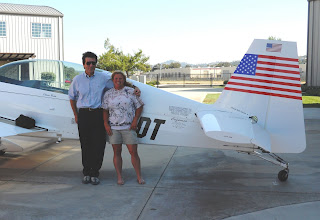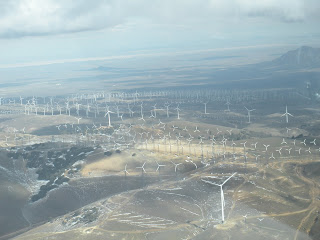The Borrego USAAAT camp had an inauspicious start. A cold front moved through the western US on late Sunday and early Monday, so that Monday morning flying plans in the Southern California desert valley town of Borrego were changed by low ceilings and rain. Doug Sowder flew his Extra 300L from Spokane, Washington, but had to wait in Klamath Falls because of snow. He made it to Borrego on Monday afternoon through pretty bad turbulence and surface winds up to 40 Knots. He was greeted in Borrego by a ghost-town airport with nobody around and the news of a major 7.2 earthquake in the area with frequent tremors and aftershocks that continued for the next several days. Malcolm and I joined Doug on Tuesday morning when the coastal range had cleared, leaving beautiful blue skies with light winds and temperatures in the 70s. Team-manager Mike Steveson arrived after a long drive from Arizona, but showing his dedication went right to work with us.
After a day of critique, we attended a reception where we were treated like celebrities by the community, board members of IAC Chapter 36 and friends. The five team members (3 pilots, the manager and the team physician) were distributed at different tables to engage in conversation with the local guests (we were trying out our official uniforms in public for the first time). Mike Steveson did an outstanding job explaining aerobatics in general and the particular challenges of world competition. He got so much attention from the local community that the question and answer session was surprisingly long, but was interesting even for seasoned aerobatic pilots. It was a remarkable event and we are thankful to the Borrego community, IAC Chapter 36 and its Board of Directors, and particularly to the Brandt Family who sponsored the reception.
Wednesday was one of the most productive training days I can remember. I don’t know whether it was the upcoming contest, the overall setup or just some masterful tactics on Mike’s part. It remains a total mystery to me, but I could see the level of flying improve in everyone who participated, faster than could be explained by routine practice alone. You watch your friends fly and think “it looks OK” and then at the end of the day watch him again and go “Oh, I have to compete against THAT? I will be in trouble if I don’t squeeze every single little point out of my sequence”. We enjoyed watching Jeff Boerboon fly and go over his plan of flying all 5
Smooth- and all 5 Star-patches in one contest. That means he would have to fly at least 16 flights during the contest, when normally he would fly 3. Due to later events he decided against doing it.
Thursday was registration and practice day for the upcoming Borrego Hammerhead Roundup Contest. The box that had been reserved for the USAAAT was open for general practice. Since I am based less than ½ hour away by airplane from Borrego, I flew home to check-in at work for that day. Mike was going to return to Arizona after my return to Borrego that evening. Everything was staged for a perfect contest. Beautiful weather in the forecast, lots of contestants pre-registered (I think 12 primary category pilots), niceties like cooler-bags and other gifts for every contestant, program booklets that were professionally printed with interesting articles, color contest posters, free Italian ice for all participants out of an electric ice-cream mini-truck driving on the airport ramp and of course good organization. The
4-min freestyle using smoke trails for the airplanes moving in synchrony to music chosen by the pilot was to be flown in the afternoon. We and local spectators were to be treated by free dinner including on the lawn of the local terminal building just left of the judges station. But plans are just that. I got a call in the early afternoon informing me about Van Snow’s fatal accident in his Harmon Rocket airplane while practicing. The cause has not been determined to my knowledge, but by witnesses accounts it appears that elevator control was lost. The plane dove at high speed into the desert floor. Mike, Jeff, Gray and Malcolm were among the first to get to the scene. Malcolm related to me that it was obvious to him, as a physician, that the impact was not survivable. All practice was stopped. All procedures were followed and officials notified immediately. Later that evening, after talking with airport and FAA authorities a briefing was held. The Contest Jury and Contest Director Gray Brandt polled the pilots about the start (or not) of the contest. Fees would be refunded for anyone who wanted to leave, even if they initially decided to fly but later, in-flight, changed their mind. A minute of silence in memory of Van marked that briefing. A few pilots and some volunteers decided to withdraw. We all wrestled with that decision. Next morning we met again and decided to continue with the contest after using until noon for practice flights for Primary and Sportsman categories. Mike changed his plans and decided to stay to volunteer as Chief Judge for every single category. In addition to Mike, Jeff Boerboon, Norm DeWitt and Brian Udell offered tremendous and invaluable help and advice to participants and organizers. Bill Bancroft spent significant time having very difficult phone conversations. Bill Hill provided his experience and calmness to help us see the big picture. Casey Erickson and Robyn Lawhon stayed on their posts and continued their duties as volunteer coordinator and registrar under very heavy pressure.
Flying started in a rather somber mood and one could feel the ambivalence in the air. The first competition flights are the same for every pilot in a particular category. These are what we call the “knowns” in
IAC competition. These flights were followed by spectacular unlimited category 4 min-freestyles. Throughout the day we had local community members come to the airport and express their support and condolences. There was also a group I think called “Quiet Skies for the Valley” that used this tragedy to petition signatures in town to banish aerobatics in Borrego. I was told they did not have much success. Jeff Boerboon’s spectacular flying in the Extra 330SC justifiably made him the 4-min-free winner. Tim Just’s flying to Frank Sinatra’s “Come Fly with Me” was a local crowd pleaser. A missing-man formation was flown immediately afterward, to honor and provide closure for those of us who knew Van. An impromptu wonderful speech by Bill Bancroft explained the tradition of the 4-ship-missing-man-formation to the audience. The formation approached and “Taps” played while airplane #3 climbed high with smoke on, leaving a clear void in our formation that continue to fly on. It was an emotional moment for all.
At the end of the first flight the USAAAT pilots were 1-2-3 in the Advanced category standings. The next day the schedule was compressed to accommodate the rest of the flights: the individually designed “frees” and the “unknowns”. The “unknowns” are only given to the pilots the day before so they have never flown that exact sequence of figures before. The circumstances were not favorable to run a smooth contest, and there were quite a few glitches, mostly caused by the emotional impact of the accident and lack of experienced volunteers. Mike’s stamina, coolness and expertise as Chief Judge, even under the most difficult conditions, kept things running smoothly. I assisted the Chief’s table during a couple of flights and felt totally useless. Mike knew every detail of what was going on flight after flight, and nothing passed unnoticed - the figures being flown, flight program interruptions, proper signaling by pilots (“wing-wags”), contestant in holding pattern, air traffic around, airplanes in landing pattern, times to let airplanes take-off, performance of grading judges, mechanical problems, and kept doing it flight after flight after flight from the briefing he held at 7AM until sunset about 7:15PM. This was followed by debriefing judges, certifying scores and revising paperwork. Surprisingly, late that night he apologized for “not doing enough critiquing and talking to us in the USAAAT about strategies and mistakes made during the contest”. I did not know what to say, but I thought, “Am I sitting next to an aerobatic version of Super-Man?” We are so lucky to have him in the USAAAT. His contest-saving expertise and work prompted the Board of Chapter 36 to make him a life-long member of the chapter. Jeff also received a life membership for his help and most expert and insightful advice. To my knowledge only Bob Branch, the founding member of Chapter 36, has previously been honored with that distinction.
We all held our breath when we saw a Decathlon taxiing downwind get hit by a gust that lifted its tail and left it standing on its nose. No injury or major damage occurred, but the incident showed us how strained we were.
Italian ice, illuminating programs, posters, and a relaxing but very late banquet and award ceremony led to the conclusion of the event.
Overall the contest turned out much better than expected. The USAAAT pilots finished in 1st and 2nd place overall. Doug flew better than I have ever seen him do. Malcolm made the very courageous, smart but painful decision to withdraw after experiencing almost loss of consciousness due to the high G- acceleration (
G-LOC) in his free, probably feeling the later effects of the stress of being the first physician on the scene of the accident. Malcolm has written and lectured about this topic; if it can happen to him it can affect any of us. He set an example for proper airmanship and consideration for safety.
For those of us on the USAAAT who attended Borrego, it was a memorable week. We as a team became much closer. It provided us with an opportunity to perform under conditions of stress, fatigue, and limited practice, trying to eliminate distractions and focus on the job at hand. In my own case, Jeff, Gray and Mike led by inspiring example. Gray Brandt, as Contest Director, provided great leadership. Much discussion was held regarding whether to proceed with the contest, the “how to do it”, and what to cut short – wide variations in opinions were expressed. Gray took advice from all sides and pondered the implications. Not only did he do his job as Contest Director under extreme conditions, but he flew Advanced in his Pitts S2B to a 4th place. That is quite a remarkable accomplishment. His fiancée Yolandi made “lemonade out of lemons” solving problems. She became an oasis of peaceful efficiency in the hot desert sun.
Several will remember this contest as one fraught with catastrophe and glitches, and probably will criticize decisions taken and things left undone. However, many of us who were there and experienced first-hand what really happened will recall the efforts of those who guided us through very difficult conditions, made us rise to the occasion and meet the challenges. It will not remain in our memory as a blunder, but to quote Gene Kranz of Apollo 13 forty-years-ago this week, we will remember it as “our finest hour”.




.JPG)

.jpg)

















